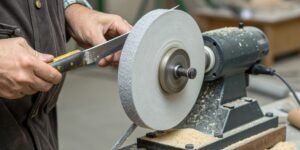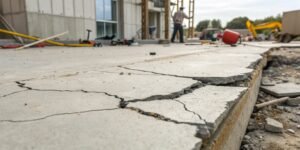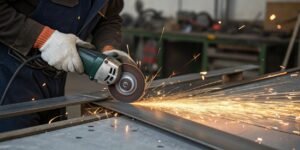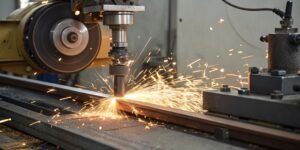
Struggling with cutting tools that wear out too fast? This hurts your bottom line and production schedule. We will show you how an excellent tool is made from the start.
Cutting tools are made by selecting top-grade raw abrasives like diamond, mixing them with a bonding agent, and then molding this mixture into the desired shape. The tool is then fired at high temperatures (sintering) and undergoes final finishing and very strict quality checks to ensure performance.

This is the basic process. But the real difference between a superior tool and a mediocre one is in the details. Each step determines if a cutting wheel will perform reliably for weeks or fail in just a few days. As a factory with nearly three decades of experience, we’ve learned that excellence isn’t an accident. It comes from mastering every stage of production. Let’s look closer at how we create the tools our customers depend on.
What raw materials are essential for high-quality cutting tools?
Are your tools failing too soon? The problem might start with the raw materials. Poor materials mean poor performance, costing you time and money with every single cut.
The best cutting tools start with superior raw materials. Superhard abrasives like diamond and cubic boron nitride (CBN) are for hard materials. Conventional abrasives like corundum and silicon carbide are for general use. The quality of these grains is the true foundation for a durable tool.

The choice of raw material is the most important decision we make. It defines the tool’s purpose and its lifespan. I remember when we first started our factory here in Henan. Finding consistent, high-purity diamond1 powder was our biggest challenge. Now, our location is a huge advantage. Henan Province produces 80% of China’s industrial diamonds. This puts us right at the source, giving us first pick of the highest quality materials. We don’t just buy abrasives; we build relationships with suppliers who meet our strict standards. This direct control from the very beginning is something not all manufacturers have. It allows us to guarantee the performance2 of our RL brand tools and the custom OEM products3 we make for our international partners.
Superhard vs. Conventional Abrasives
We group our primary materials into two main categories. Each is suited for different tasks.
| Abrasive Type | Key Materials | Best For |
|---|---|---|
| Superhard | Diamond, Cubic Boron Nitride (CBN) | Hardened steel, ceramics, glass, concrete, stone |
| Conventional | Corundum (Aluminum Oxide), Silicon Carbide | Softer steels, cast iron, non-ferrous metals, wood |
Choosing the right abrasive ensures efficiency and a clean cut. Using the wrong one leads to rapid wear and poor results.
How does the mixing and molding process work?
Do you worry about inconsistent performance from tool to tool? An uneven mixture of materials is often the real cause. This creates unpredictable wear and cuts, disrupting your production flow.
This process involves carefully measuring and mixing abrasive grains with a specific bonding agent, such as resin, metal, or vitrified ceramic. This blend is then put into a mold and pressed under high pressure to form the tool’s initial shape, like a blade or a wheel.

Think of making a cutting tool like baking a cake. If the flour and sugar are not mixed perfectly, you get a bad result. It’s exactly the same for our grinding wheels. We use large, computer-controlled mixers to ensure every single abrasive grain is evenly coated with the bonding agent4. This step is critical for consistent performance. If the mix is not uniform, the wheel will have hard and soft spots. It will wear unevenly and may even fail under stress. After mixing, we put the material into high-precision molds. A press then applies immense pressure, compacting the powder into a solid "green" wheel. This pre-sintered form is fragile but has the exact shape and density needed for the next, most critical step: the furnace.
The Role of the Bonding Agent
The bonding agent is the glue that holds the abrasive grains together. The type of bond we use dramatically changes the tool’s characteristics.
- Resin Bond: These are organic bonds. They are softer and allow for cooler cutting. They are ideal for applications where heat can damage the workpiece.
- Metal Bond: These use metal powders to hold the abrasives. They are extremely durable and long-lasting, perfect for cutting hard, abrasive materials like concrete and stone.
- Vitrified Bond: This is a ceramic bond. It creates a very rigid, porous structure that is excellent for high-precision grinding.
Why is the sintering process so critical?
Have you ever had a cutting disc simply fall apart during use? This dangerous failure often points to a poor sintering process. It is a critical step that many factories overlook.
Sintering is a high-temperature firing process in a special furnace. It doesn’t melt the materials but fuses the bonding agent and abrasive grains together. This chemical reaction creates a strong, solid structure, giving the cutting tool its final strength, hardness, and heat resistance.

In our factory, we call the sintering5 furnace "the heart" of the production line. This is where the loose, powdery pre-form becomes a tough, unified cutting tool. We place the molded wheels into a long, tunnel-like furnace where the temperature is controlled with extreme precision. The exact temperature curve—how fast it heats up, how long it stays at peak temperature, and how slowly it cools—is a proprietary recipe we have perfected over nearly 30 years. If the temperature is just a few degrees off, or the timing is wrong, an entire batch of hundreds of wheels can be ruined. They might look fine, but they won’t have the internal strength to withstand the forces of high-speed cutting. This is what separates a truly reliable tool from one that chips, wobbles, or breaks under pressure. It’s a combination of science and hard-won experience.
What happens during the finishing and quality control stages?
You get a new batch of tools, but they don’t fit your machines or perform as expected. This inconsistency costs you downtime and money. Proper quality control should prevent this.
After sintering, tools go through finishing. This includes truing, dressing, and balancing to meet exact specifications. Then, our strict quality control process checks for dimensions, balance, and structural integrity. Only tools that pass every single test are approved for shipping.

A cutting tool is not finished when it comes out of the furnace. It’s strong, but it’s not perfect yet. First, it goes to our finishing department. Here, we use diamond dressing tools to make sure the wheel is perfectly flat and its diameter is accurate to the micrometer. The most important step here is balancing6. An unbalanced wheel will vibrate at high speeds, leading to poor cuts and unsafe operation. We test every single superhard tool on a dynamic balancing machine. This is a step many competitors skip to save costs, but for us, it’s non-negotiable. After finishing, the tool faces its final test: our Quality Control team. They perform a final check on dimensions, look for any visual defects like cracks or chips, and run speed-stress tests. For one of our a European clients, we have a three-stage balancing test because their machines run at incredibly high speeds. This is the kind of detail we focus on. For us, ‘good enough’ is never good enough. Our name is Reliable for a reason, and our final QC checks are where we prove it every day.
Conclusion
Making a quality cutting tool is a detailed manufacturing process. From raw materials to final checks, every step matters. We are proud to build durable, high-performance tools you can trust.
-
Find out why diamond is a preferred material for cutting tools and its benefits. ↩
-
Find strategies to enhance the performance and lifespan of cutting tools. ↩
-
Discover the significance of OEM products in the cutting tool industry. ↩
-
Discover the different bonding agents and how they affect cutting tool performance. ↩
-
Understand the critical sintering process that ensures the strength of cutting tools. ↩
-
Discover why balancing is crucial for the safe and effective operation of cutting tools. ↩
Written by
leeon
You may also be interested in:

How to use a hard felt bench grinding wheel on knives?
Getting a razor-sharp, polished edge on a knife can be frustrating and slow. A dull knife is dangerous, and using the wrong tool can easily

What are grinding cracks and how do you stop them?
Are tiny cracks appearing on your ground surfaces? This problem leads to part failure, wasting time and money. You can solve it by understanding the

What does an angle grinder do that other tools can't?
Struggling with tools for multiple tasks? Carrying a heavy toolbox is inefficient. An angle grinder replaces many tools, saving you time and effort on the

How to reduce the cycle time in a grinding machine?
Is your grinding process a major bottleneck? Slow cycle times hurt your bottom line and delay deliveries. You can speed up production by optimizing key

Do you regularly sharpen your chisels? If so, how?
A dull chisel ruins wood and causes frustration. This wastes time and expensive materials. Learning to sharpen correctly is the simple, game-changing solution you need

Which material is used in making cutting wheel?
Have you ever used a cutting wheel that wore out too fast or just wouldn’t cut? The right material is key to solving this problem
